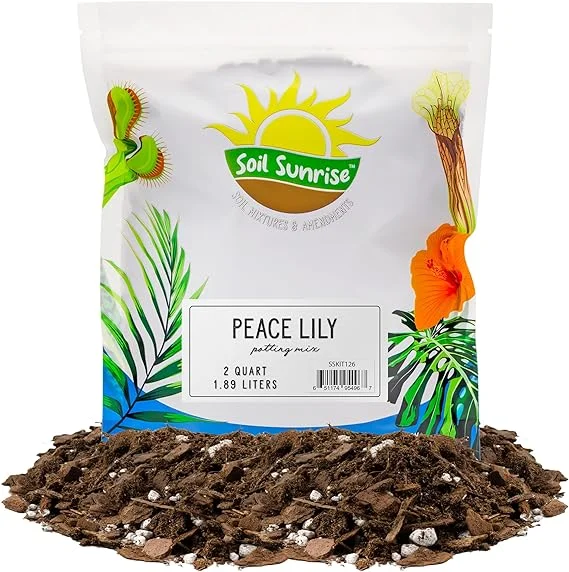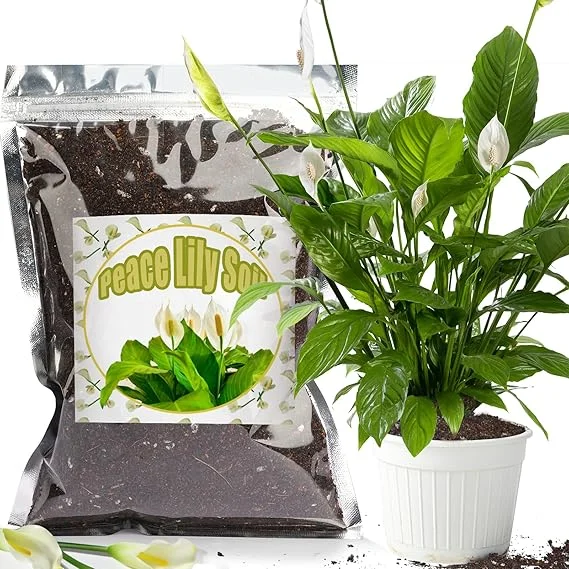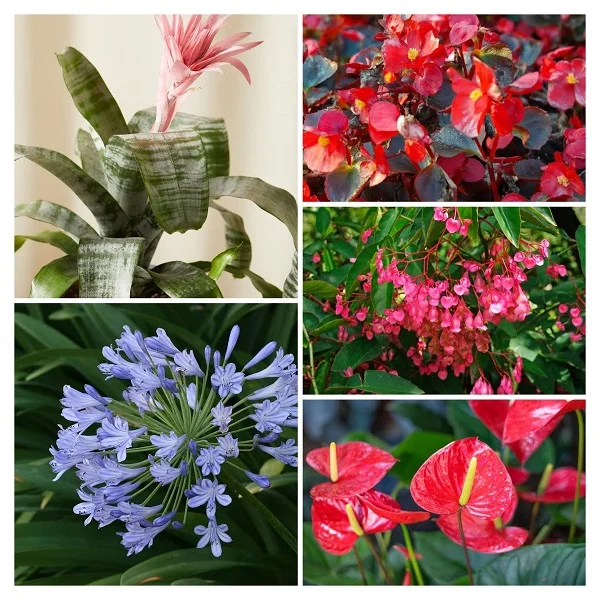Spathiphyllum wallisii (Peace Lily) Care Indoors, Propagation, Problems and Solutions
Some links in this post may be affiliate links
Spathiphyllum wallisii (Peace Lily) grows best in bright indirect light, average warmth, moderate humidity and moderately moist, rich, well-drained soil coupled with monthly feeding in the growing season.
Peace Lily also called White Sails or Spathe Flower is one of the most popular plants on account of its ability to clean indoor air while the dark-green glossy leaves and white blooms will brighten any space.
The bloom is a spathe which appears pale green as it begins to grow and turns white at it opens. It surrounds a spadix that is densely covered by tiny, white flowers.
Spathe Flowers are tropical evergreens which grow from underground rhizomes and are easy to grow even for a beginner.
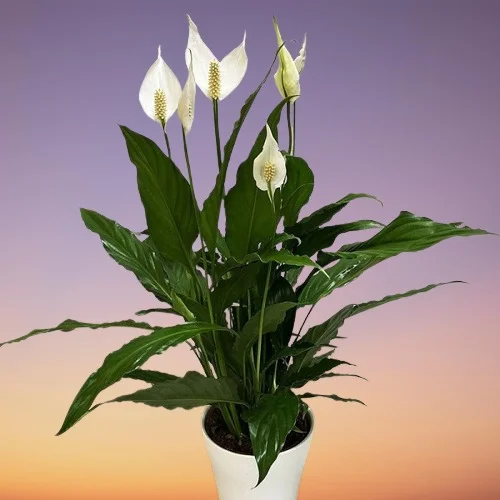
Botanical name: Spathiphyllum wallisii
Family: Araceae
Common names: Peace Lily, White Sails, Spathe Flower
Origin
Spathiphyllum wallisii is native to the tropical rainforests of Central America and Southeastern Asia. In its natural enviroment, it grows in consistently humid conditions on the forest floors where it receives filtered sunlight.
Size
White sails can grow to a height of 3 feet which makes it very versatile. It can be grown as a table-top plant, on top of a shelf or even in a floor positioned pot. It is among the best plants for a study table to boost concentration & productivity
Varieties
Peace Lily has many hybrids and cultivars like Mauna Loa, Sensation, White Stripe and Domino among others.
Air Cleaning
According to the NASA Clean Air Study, Spathiphyllum wallisii was found to be among the best air-purifying plants and gets rid of xylene, toulene, benzene, formaldehyde and ammonia from indoor air.
Is Spathiphyllum wallisii toxic?
Peace Lily though called lily is not a true lily. Therefore, it is not as much toxic as true lilies and is only mildly toxic to humans and pets according to ASPCA.
Spathe Flower contains Calcium oxalate crystals which can cause skin irritation, a burning sensation in the mouth, difficulty swallowing and nausea. It does not contain toxins that are found in true lilies which can cause acute kidney failure in cats and dogs.
Where to Buy
If you are looking to add Peace Lily to your collection, they are available online on Amazon (Link to Amazon).
How to care for Spathiphyllum wallisii indoors
Caring for Spathiphyllum wallisii indoors entails giving it bright indirect light (filtered light), average warmth of 18-260C, moderate humidity of 50-55% and moderately moist, fertile, well-drained soil coupled with monthly feeding during the growing season.
Peace Lily care requires repotting only when pot-bound as it blooms best when the roots are confined. Pruning is necessary to keep the plant neat as well as discourage pest and disease infestations. Keep reading for more on these growing conditions and how to achieve them.
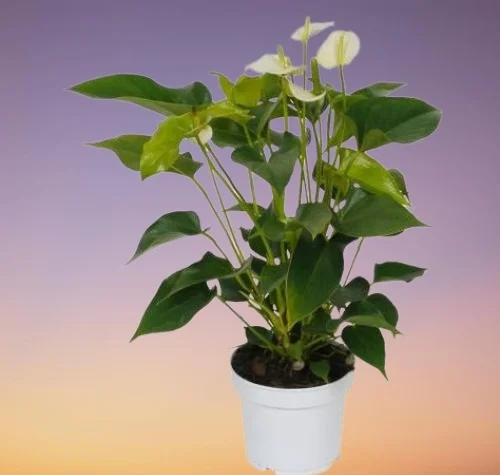
Watering
How often should I water Spathiphyllum wallisii?
Water your Spathiphyllum wallisii liberally in spring and summer while allowing the top 2-3 inches of soil to dry out between waterings. Maintain the soil moderately moist and avoid overwatering to prevent yellowing and rotting.
Decrease watering in fall and winter to keep the soil slightly moist as growth is minimal at this time and so the plant will not require a lot of water. However, do not allow the soil to dry out completely to avoid wilting and drooping leaves.
Use room temperature water as cold water can shock this tropical plant resulting in reduced growth. Ensure that the water is chlorine-free as the plant is sensitive to chlorine and other chemicals dissolved in water.
To avoid getting soggy soil which can lead to root-rot and death of the plant, confirm that the pot has a drainage hole and the soil is well-draining.
Light Requirements
Do Spathiphyllum wallisii need direct sunlight?
No. Spathiphyllum wallisii flourishes in bright indirect light (partial shade). Keep it away from direct sunshine to avoid scorching of the leaves.
If the light is too little, growth will be slowed and the plant will not bloom. Therefore, instal a full spectrum grow light where the natural lighting is not adequate.
Regularly rotate the pot to ensure that the plant receives light on all sides for even growth to prevent unbalanced growth.
Temperature and Humidity
Spathiphyllum wallisii thrives in an average warmth of 18-260C. A room temperature that is comfortable for you is ideal for the plant.
Keep it away from cold and hot drafts to prevent sudden changes in temperature as they can cause reduced growth and dry shrivelled leaves.
Average humidity of 50-55% is adequate for Peace Lily. However, if the air is too dry, the plant may develop brown leaf tips and edges. To upscale humidity, set the pot on a wet pebble tray or use a cool mist humidifier. Maintain good air circulation to prevent fungal diseases.
Potting soil
The best potting soil for Peace Lily is a rich, free-draining mix to prevent it from getting soggy while providing the required nutrients. Most Peace Lily potting mixes are ideal for the plant.
Fertilizer
Feed your Spathiphyllum wallisii with a phosphorous-rich, water-soluble fertilizer monthly in spring and summer to encourage flowering. Withhold feeding in fall and winter as growth is minimal at this time.
Peace Lily is sensitive to salts buildup in the soil therefore, regularly flush out excess chemical deposits by running a stream of water through the soil until water comes out through the drainage hole. Let the stream of water run for a few minutes.
Repotting
Keep your Spathiphyllum wallisii pot-bound to promote flowering; repot during the growing period only when it has outgrown its current pot. Use a pot that is only 1 size larger than the current one.
During repotting, divide large plants to allow adequate room for growth in the new pot. Cut through the rhizomes with a sharp sterile knife and pot the sections in individual pots.
Ensure that the pot has a drainage hole and the soil is well-draining to avoid waterlogging as it can lead to root-rot. Check out these pots with drainage holes on Amazon.
Pruning & Maintenance
Pruning Spathiphyllum wallisii involves removal of dead leaves to keep the plant neat and also minimize pest and disease infestations.
Once the blooms are spent, cut them off as close to the base as possible to maintain the plant neat and tidy.
Occasionally clean the leaves by damp-wiping with a soft cloth to get rid of dust and reduce infestation by pests.
Spathiphyllum wallisii Propagation
Spathiphyllum wallisii (Peace Lily) propagation is done at the beginning of the growing season by division of mature plants.
Propagating Peace Lily by plant division
- Water the plant thoroughly at least 1 day before to make it easier to divide and also hasten establishment.
- Remove the plant from its pot and carefully divide the rhizome into several sections while ensuring that each division has at least 2 leaves and some roots.
- Pot the sections into individual pots in moist, free-draining soil that is rich in organic matter.
- Wet soil thoroughly and place the set up in a warm, well-lit place away from direct sunlight.
- Maintain the soil consistently moist thorough out but not soggy. The sections may wilt slightly due to the repotting shock but they will recover with time.
- Allow the new plant adequate time to be well established before moving it to its display position and beginning routine care.
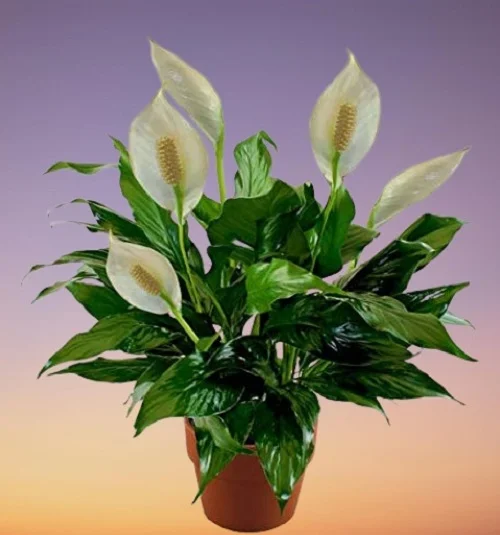
Spathiphyllum wallisii Problems & Remedies
Spathiphyllum wallisii (Peace Lily) problems are yellow leaves, drooping leaves, plant dying, lack of blooms, brown leaf tips, pests, diseases among others. Keep reading for more on these problems and how to fix them.
Yellow leaves
Yellow leaves on Spathiphyllum wallisii are caused by poor lighting, inconsistent watering, low humidity, nutrients deficiency, extreme temperatures, diseases, pests among others.
Here are 13 Causes of Peace Lily Yellow Leaves & How to Fix Them.
Drooping leaves
Drooping leaves on Peace Lily is caused by varied reasons like overwatering, underwatering, temperature stress, direct sunlight, dry air, pests infestations, diseases and others.
Take a look at these 10 Reasons Peace Lily is Drooping and How to Revive It.
Plant dying
Peace Lily is dying due to too little light, incorrect watering, being extremely pot-bound, pest infestations, root-rot, direct sunlight, drafts, cold water among others.
Read more on these 12 Reasons Why Peace Lily is Dying and How to Revive It.
Lack of blooms
There are several reasons why your Peace Lily is not blooming which include low light, overwatering, underwatering, underfeeding, low air humidity, wrong temperature, root-rot and pests among others.
Check out these 11 Reasons Why Peace Lily is Not Blooming and How to Fix Them.
Brown leaf tips
Brown leaf tips on Spathiphyllum wallisii are caused by inconsistent watering, low humidity, and salts buildup.
How to fix it
Inconsistent watering: Water when the top 2-3 inches of soil dry out. Do not water on a schedule.
Low humidity: To raise humidity, set the pot on a wet pebble tray, use a humidifier or grow the plant in a well-lit bathroom, kitchen and other humid areas of the home.
Salts build up: Regularly flush out excess salts from the soil by running a stream of water through the soil until the water comes out through the drainage hole.
Yellow leaf edges
Yellow leaf edges on Peace Lily are due to lack of micronutrients like Magnesium and Iron in the soil. Feed it with a phosphorous-rich, water-soluble fertilizer that contains micronutrients monthly in spring and summer.
Brown, dry leaf spots
Brown dry leaf spot on Spathiphyllum wallisii are an indication of scorching due to exposure to direct sunlight. Move the plant to a more shaded place or instal a light curtain to filter the light as the plant prefers dappled light (bright indirect light).
Green colored blooms
Green colored blooms on Peace Lily are due to overfeeding. Reduce the amount of fertilizer by as much as half and observe the result. In addition, do not feed in fall and winter.
Pests
Spathiphyllum wallisii is fairly resistant to pests. However, weak plants can be attacked by mealybugs, aphids, fungus gnats and spider mites.
How to fix it
- Check underneath the leaves regularly for these pests and take timely control measures.
- Isolate the affected plant to prevent spread to other plants.
- Treat the infested plant with neem oil or insecticidal soap as per the manufacturer's recommendations.
- Damp-wipe the leaves regularly with a soft cloth to discourage the pests.
- Keep the plant well pruned to minimize the hiding and breeding ground for these pests.
Diseases
Peace Lily is prone to root-rot which is prevalent in soggy soil. The disease is characterized by yellowing and wilting of the leaves which is rapidly followed by browning and plant collapse.
How to fix it
- Carefully slip the plant out of its pot and inspect the roots.
- Trim brown-black, mushy roots and treat the healthy roots with a copper-based fungicidal solution as indicated by the manufacturer.
- Disinfect the pot with the fungicidal solution or use a fresh pot to repot the plant in fresh, well-draining soil.
- Do not water the plant immediately and keep it dry for 5-7 days before you can resume watering.
- Use a pot with a drainage hole and well-draining soil to prevent the soil from soggy.
- Lessen watering in fall and winter as growth is minimal at this time; keep the soil slightly moist.
You liked it? Share on social media.
Related Content
Amazon Associates Disclosure
Homeplantsguide.com is a participant in the Amazon Services LLC Associates Program, an affiliate advertising program designed to provide a means for sites to earn advertising fees by advertising and linking to amazon.com.

